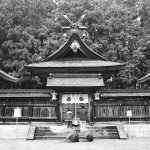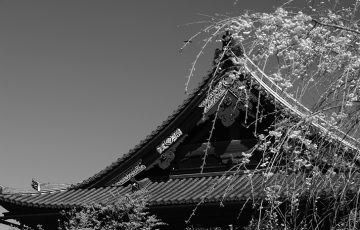 A lot of people don’t much like Nagoya, at least on first contact. The complaints about its heat and lack of greenery usually come later. The first thing most people feel when they alight at Nagoya Station is bewilderment. If you like this sort of thing — infinities of shops, the hum and thrum of commerce — you may be awed; otherwise, panic may set in.
A lot of people don’t much like Nagoya, at least on first contact. The complaints about its heat and lack of greenery usually come later. The first thing most people feel when they alight at Nagoya Station is bewilderment. If you like this sort of thing — infinities of shops, the hum and thrum of commerce — you may be awed; otherwise, panic may set in.
A traveler in the early 1960s, consulting the ‘Official Guide,’ commented that, so important industrially was Nagoya, the visitor is “advised to break his journey at this city to inspect its activities, especially the manufacture of porcelain and cloisonné. This traveler, however, felt no urge to do so.”
Lying between Tokyo and Kyoto, Nagoya is sometimes referred to as Chukyo, the Middle Capital. Some visitors sing its praises. Sacheverell Sitwell, an Englishman from a distinguished writing family that included Edith and Sir Osbert Sitwell, only spent an afternoon in Nagoya, one day in 1958 in the still war ravaged city, but roundly praised it. He was rightly optimistic when he wrote, “When the plans are completed it will be a fine modern town.”
Sitwell and his wife had stopped here in the hope of tracking down some chin dogs (Japanese spaniels), a rare breed. The owners of Cavalier spaniels, their English equivalents, the Sitwells were a determined couple. After their chauffeur had patiently phoned up the police and every pet shop in Nagoya on behalf of this eccentric but well-connected English couple, a pair of spaniels were duly found. They also discovered a rather good restaurant, close to some burned temples, where there were “maids and scullions at work in clean linen fresh from some celestial snowdrift laundry, most of them wearing masks to spare us the contagion of their breath. After such an experience one feels one can never eat again in Soho!”
The places where I ate, mostly in the commercial and entertainment district of Sakae, were clean but not obsessively so. Noisy, well-supported eateries with plenty of hearty Chinese dishes on the menu, they were unfussy restaurants where you could sit at the counter and watch the woks being fired up by cooks in oil-spattered aprons and burn marks on their wrists.
I tend to evaluate cities by whether I think I could live in them or not. Comfortably, yes, was my conclusion about Nagoya. Contentedly? I wasn’t sure about that, though I came to admire the well-dressed, purposeful people I saw in the streets and shops, their determination to live in the present. The city re-energized me, but the absence of visible history explained why I might not elect to live in the city. I did manage though to smoke out some minor but impressive heritage.
A journey into the past could easily start at the superb Tokugawa Art Museum. A treasure house of history, it comes as a surprise after the city’s unflagging modernity. The museum displays items owned by the Owari branch of the Tokugawa clan who ruled Nagoya. The costumes, reconstructed chambers and art collections hint at the civilized life enjoyed by the family. Very rare scroll paintings of the Genji Monogatari show long-haired court ladies, floating across verandahs in twelve-layered, lavish kimonos, the very image of privilege, life as a work of art.
Within the same grounds as the museum is the Tokugawa-en, a 17th century garden. Destroyed in the air raids of wars past, it was only renovated a wfew years ago. An Edo era stroll garden, it has some attractive features, including a large pond, waterfalls, well-placed rocks and a particularly elegant teahouse which, from the yellow wood and smell, must have been built quite recently.
From the museum I walked a couple of kilometers west to the district of Futaba and its so-called ‘Culture Path.’ This well-to-do district was associated in my mind with the Meiji and Taisho era personage of Sadayakko Kawakami. A successful geisha from Tokyo, who had reinvented herself as an actress, dancer and theater manager, Madame Sadayakko as she liked to be addressed, was the first person to take Japanese theater groups abroad. Touring London, St Petersburg, Vienna, Paris, New York, Boston and other major Western cities where performing arts audiences were eager to see what Japan had to offer, heads of state watched enthralled as she danced on stage. Picasso painted her, Puccini modeled his Madame Butterfly after her. She was a sensation wherever she went. Jean Lorrain wrote of her that she was like, “an opium hallucination of the Far East, elegant and fragile like an Utamaro print.” Off stage, she was also a hard-nosed businesswoman, an opportunist who knew how to play up to the West’s fascination with all things Oriental.
The money she made allowed her among other things, to build a rather grand house in this district of Nagoya. Completed in 1919, it has been carefully maintained. According to Lesley Downer, Sadayakko’s English biographer, the house “might have been a Moorish palace or a Spanish villa transported to Japan. As far as most people were concerned, it was the last word in glamour and perfectly suited to Sada’s sparkling, rather showy personality.” Sadayakko called it the Futaba House; everyone else called it the Futaba Palace. The only thing that may have changed are the grounds. In Sadayyakko’s day, we know that she was driven in a Packard through wooded grounds, past landscaped gardens and ponds to reach her front door, which today stands just a few meters from a public road.
 Nagoya Castle lies to the west of the Futaba area, but before entering its grounds, spare a few minutes for the Nagoya City Archives building just off Dekimachi-dori. The 1922 structure was formerly used as the Nagoya Superior court building. A Taisho era piece of architecture, it has strong traces of the Meiji period’s taste for hybrid styles of neo-baroque. A superlative design, its white granite and red brick surfaces, black slate roofs and green bronze plating, have acquired a patina of age that only adds to the dignity of the building. It even has its original dome-shaped lamps mounted on brick columns at the entrances to the grounds. Designated an important cultural asset, few visitors take the trouble to seek it out.
Nagoya Castle lies to the west of the Futaba area, but before entering its grounds, spare a few minutes for the Nagoya City Archives building just off Dekimachi-dori. The 1922 structure was formerly used as the Nagoya Superior court building. A Taisho era piece of architecture, it has strong traces of the Meiji period’s taste for hybrid styles of neo-baroque. A superlative design, its white granite and red brick surfaces, black slate roofs and green bronze plating, have acquired a patina of age that only adds to the dignity of the building. It even has its original dome-shaped lamps mounted on brick columns at the entrances to the grounds. Designated an important cultural asset, few visitors take the trouble to seek it out.
Nagoya Castle is a different thing. The city’s main draw card, the castle, though a replica of the original 1612 structure incinerated in the air raids, attracts a large crowd. Fortunately, the grounds are large enough to absorb everyone. The 1959 reconstruction we see today is a very decent effort at recreating the castle, right down to details like the pair of golden shachi (mythical dolphins) that top the central donjon and serve as the symbol of the city. An elevator, whisking you between floors, soon reminds you though, of what century it actually is. It wasn’t that long ago you might have been able to see the prototype. According to “Terry’s Japan, 1920,” an old English guidebook, there were sliding doors on the top floor of the keep, with seats “where sentinels kept watch, night and day, over the plain, and there was a table in the centre with scores of lines radiating in all directions, like sunbeams, with names of towns, roads and passes whence enemies might come.”
Taking the subway back to Sakae, into the maw of the contemporary city, it was good in a way to see that the living had prevailed, that the new had something to offer the people living here, who clearly preferred to live in the here and now. Everything I noted, worked beautifully, the streets were clean and safe. People found polite accommodations to help them co-exist in the crowds. Name a commodity and the chances were you could find it. It wasn’t pushing itself as a tourist destination, either; its main interests were in commerce and industry, and it had always done well by them. Visitors were welcome but the city, unlike Kyoto and Nara, didn’t need them to affirm its prosperity. I liked its self-sufficiency and assertiveness.
In a way it was a perfect city, one that had triumphed over the past by putting it where it belonged, at the rear of time.
TRAVEL INFORMATION
A major transportation hub, the city is well served by bullet trains. It’s also the terminus for the Meitetsu and Kinsetsu lines. Nagoya has two airports, the biggest is the Central Japan International Airport. Its useful subway system has four lines. The Chisun Inn Nagoyasakae (052-962-2411) is a comfortable business hotel just a few minutes from Sakae subway. The Hotel Grand Court Nagoya (052-683-4111) is a good base for exploring southern Nagoya. It’s expensive, though. Sakae is one of the best areas to eat and is jam packed with tasty Japanese and Chinese places, some very cheap. For English books (tough, you won’t find much on Nagoya), try Maruzen in Sakae or Sanseido in the Takashimaya store in the JR Central Towers.
Story & photos by Stephen Mansfield
From J SELECT Magazine, December 2008











-360x230.jpeg)



Recent Comments